Symmetrical Traditional Patterns and User Perception: A Study on Innovation in Home Textile Design
Abstract
1. Introduction
2. Literature Review
2.1. Traditional Pattern and Textile Design
2.2. User Perception and Innovation in Home Textile Design
2.3. Design Decision—Making and Scheme Verification
3. Methodology
3.1. Proposed Framework
- The Affinity Diagram is used to collect and organize 10 core affective vocabularies related to HTD. A perceptual cognition questionnaire is then constructed to collect consumer evaluations of home textile products featuring TPs, ensuring that the data reflect intuitive user perceptions of emotional and visual qualities;
- PCA is applied to the questionnaire data to extract key perceptual factors, which represent users’ cognitive-emotional responses;
- The perceptual cognition factors are divided in the criterion layer, with the core affective vocabularies forming the sub-criterion layer. Design experts assign weights to the 10 affective vocabularies using the FAHP method, allowing for the calculation of the relative importance of each perceptual factor in HTD;
- A selection of 5 representative HFoJ TPs is analyzed to uncover their cultural meanings and design potential. Shape grammar is employed to reinterpret and innovate these patterns while preserving their cultural characteristics;
- Based on the weighed affective vocabularies and 10 reinterpreted TP variants, a QFD mapping model is constructed to link perceptual needs with design attributes. The model is then used to identify the optimal patterns for home textile product development;
- Using the top 3 ranked patterns, 3 home textile product design schemes are created. These schemes are refined by integrating different design elements and materials to ensure functionality and aesthetic appeal;
- Experts assess the 3 design schemes using the GRA method to determine the most effective design from an emotional and cultural standpoint;
- The selected optimal pattern is applied in actual HTD practice. Consumers are invited to evaluate the final design scheme to assess its market feasibility and emotional resonance.
3.2. Affinity Diagram
3.3. Principal Component Analysis
3.4. Shape Grammar
3.5. Fuzzy Hierarchical Analysis
3.6. QFD
3.7. Grey Relation Analysis
4. Case Study
4.1. Collection and Classification of Affective Vocabularies
4.2. Pattern Sorting and Reconstruction
4.3. Assign Weights to Affective Vocabularies
4.4. Pattern Scheme Ranking and Design Practice
4.5. Decision Making for Home Textile Scheme Design
5. Discussions
5.1. Sensitivity Analysis
5.2. Comparison with Previous Studies
5.3. Home Textile Design Strategies
6. Conclusions
Author Contributions
Funding
Data Availability Statement
Conflicts of Interest
Abbreviations
| HFoJ | Homespun Fabric of Jiangnan |
| TP | Traditional Patterns |
| CRs | Customer requirements |
| HTD | Home Textile Design |
| KE | Kansei Engineering |
| CI | Consistency Index |
| CR | Consistency Ratio |
| ECs | Engineering Characteristics |
| QFD | Quality Function Deployment |
| PCA | Principal Component Analysis |
| FAHP | Fuzzy Analytic Hierarchy Process |
Appendix A
| NO | Definition | Sample Serial Number | Ranking | ||
|---|---|---|---|---|---|
| G1 | G2 | G3 | |||
| Expt. 1 | ωN1–5 = 1 | 0.879 | 0.554 | 0.400 | G1> G3 > G2 |
| Expt. 2 | ωN1–5 = 3 | 0.879 | 0.554 | 0.400 | G1> G3> G2 |
| Expt. 3 | ωN1–5 = 5 | 0.879 | 0.554 | 0.400 | G1> G3> G2 |
| Expt. 4 | ωN1–5 = 7 | 0.879 | 0.554 | 0.400 | G1> G3> G2 |
| Expt. 5 | ωN1–5 = 9 | 0.879 | 0.554 | 0.400 | G1> G3> G2 |
| Expt. 6 | ωN1 = 1, ωN2–5 = 9 | 0.879 | 0.643 | 0.491 | G1> G3> G2 |
| Expt. 7 | ωN2 = 1, ωN1,N3–5 = 9 | 0.879 | 0.639 | 0.485 | G1> G3> G2 |
| Expt. 8 | ωN3 = 1, ωN1–2,N4–5 = 9 | 0.879 | 0.631 | 0.491 | G1> G3> G2 |
| Expt. 9 | ωN4 = 1, ωN1–3,N5 = 9 | 0.959 | 0.526 | 0.472 | G1> G3> G2 |
| Expt. 10 | ωN5 = 1, ωN1–4 = 9 | 0.879 | 0.649 | 0.492 | G1> G3> G2 |
References
- Lee, S.K.; Koo, S. Development of three-dimensional printed cultural fashion products using symbols of longevity. Text. Res. J. 2022, 92, 4484–4500. [Google Scholar] [CrossRef]
- Jowers, I.; Earl, C.; Stiny, G. Shapes, structures and shape grammar implementation. Comput. Aided Design 2019, 111, 80–92. [Google Scholar] [CrossRef]
- Zou, Y.; Zhao, C.; Childs, P.; Luh, D. Cross-cultural design in costume: Case study on totemic symbols of China and Thailand. Hum. Soc. Sci. Commun. 2024, 11, 1263. [Google Scholar] [CrossRef]
- Miao, H.; Wen, R. Wedding Bed Textiles Design Based on Chinese Traditional Auspicious Patterns. In Proceedings of the 7th International Conference on Arts, Design and Contemporary Education (ICADCE 2021), Moscow, Russia, 25–26 May 2021. [Google Scholar] [CrossRef]
- Shen, Y. Evaluation and Selection of Cultural and Creative Design Solutions Based on Grey Correlation Multicriteria Decision Analysis. Math. Probl. Eng. 2022, 2022, 1–9. [Google Scholar] [CrossRef]
- Chen, D.; Cheng, P.; Simatrang, S.; Joneurairatana, E. Kansei engineering as a tool for the design of traditional pattern. Autex Res. J. 2021, 21, 125–134. [Google Scholar] [CrossRef]
- Chen, D.; Cheng, P. Research on the image design of clothing patterns. Fibres Text. East. Eur. 2024, 32, 17–24. [Google Scholar] [CrossRef]
- An, S.; Guo, Z.; Fang, H. Study on the Kansei Image of Linear Elements of Wooden Screens on the Basis of Modern Aesthetics. Forest Prod. J. 2022, 72, 258–264. [Google Scholar] [CrossRef]
- Song, Y.; Zhang, N.; Wu, T. Image evaluation and analysis of fabric with a geometric motif in dress style design. Ind. Textila 2024, 75, 591–598. [Google Scholar] [CrossRef]
- Quan, H.; Li, S.; Hu, J. Product Innovation Design Based on Deep Learning and Kansei Engineering. Appl. Sci. 2018, 8, 2397. [Google Scholar] [CrossRef]
- Gao, M.; Cao, X.; Qian, L. Cultural Echoes in Modern Design: Assessing Young Consumers’ Perceptions of Traditional Bamboo Weaving Patterns. Complexity 2024, 2024, 5524490. [Google Scholar] [CrossRef]
- Cui, J.; Tang, M. Integrating shape grammars into a generative system for Zhuang ethnic embroidery design exploration. Comput. Aided Design 2013, 45, 591–604. [Google Scholar] [CrossRef]
- Guo, F.; Liu, W.; Liu, F.; Wang, H.; Wang, T. Emotional design method of product presented in multi-dimensional variables based on Kansei Engineering. J. Eng. Design 2014, 25, 194–212. [Google Scholar] [CrossRef]
- Wang, C.; Zhang, J.; Liu, D.; Cai, Y.; Gu, Q. An AI-Powered Product Identity Form Design Method Based on Shape Grammar and Kansei Engineering: Integrating Midjourney and Grey-AHP-QFD. Appl. Sci. 2024, 14, 7444. [Google Scholar] [CrossRef]
- Wang, T.; Yang, L. Combining GRA with a Fuzzy QFD Model for the New Product Design and Development of Wickerwork Lamps. Sustainability 2023, 15, 4208. [Google Scholar] [CrossRef]
- Lee, P.; Han, Q. User-centric sustainable design in mass-customized housing using Kano model and quality function deployment. Archit. Eng. Des. Manag. 2025, 1–17. [Google Scholar] [CrossRef]
- Wang, Z.; Han, C.; Yu, B.; Wei, K.; Li, Y.; Jin, S.; Bai, P. The Emotional Design of Street Furniture Based on Kano Modeling. Buildings 2024, 14, 3896. [Google Scholar] [CrossRef]
- Xu, H.; Song, H. Key Factors Influencing Chinese Consumers’ Demand for Naturally Dyed Garments: Data Analysis through KJ Method and KANO Model. Sustainability 2024, 16, 1189. [Google Scholar] [CrossRef]
- Apichonbancha, P.; Lin, R.; Chuang, C. Integration of Principal Component Analysis with AHP-QFD for Improved Product Design Decision-Making. Appl. Sci. 2024, 14, 5976. [Google Scholar] [CrossRef]
- Oster, A.; McCormack, J. A Methodology for Creating Shape Rules During Product Design. J. Mech. Design 2011, 133, 61007. [Google Scholar] [CrossRef]
- McKay, A.; Stiny, G.; de Pennington, A. Principles for the definition of design structures. Int. J. Comput. Integ M. 2016, 29, 237–250. [Google Scholar] [CrossRef]
- Tošović-Stevanović, A.; Ristanović, V.; Ćalović, D.; Lalić, G.; Žuža, M.; Cvijanović, G. Small Farm Business Analysis Using the AHP Model for Efficient Assessment of Distribution Channels. Sustainability 2020, 12, 10479. [Google Scholar] [CrossRef]
- Yu, S.; Liu, M.; Chen, L.; Chen, Y.; Yao, L. Emotional Design and Evaluation of Children’s Furniture Based on AHP-TOPSIS. Bioresources 2024, 19, 7418–7433. [Google Scholar] [CrossRef]
- Zheng, H.; Liu, L.; Zhang, Q.; Wang, Y.; Wei, Y. Children’s Hospital Environment Design Based on AHP/QFD and Other Theoretical Models. Buildings 2024, 14, 1499. [Google Scholar] [CrossRef]
- Wang, T.; Zhang, Q.; Chong, H.; Wang, X. Integrated Supplier Selection Framework in a Resilient Construction Supply Chain: An Approach via Analytic Hierarchy Process (AHP) and Grey Relational Analysis (GRA). Sustainability 2017, 9, 289. [Google Scholar] [CrossRef]
- Dai, Z.; Scott, M. Product platform design through sensitivity analysis and cluster analysis. J. Intell. Manuf. 2007, 18, 97–113. [Google Scholar] [CrossRef]
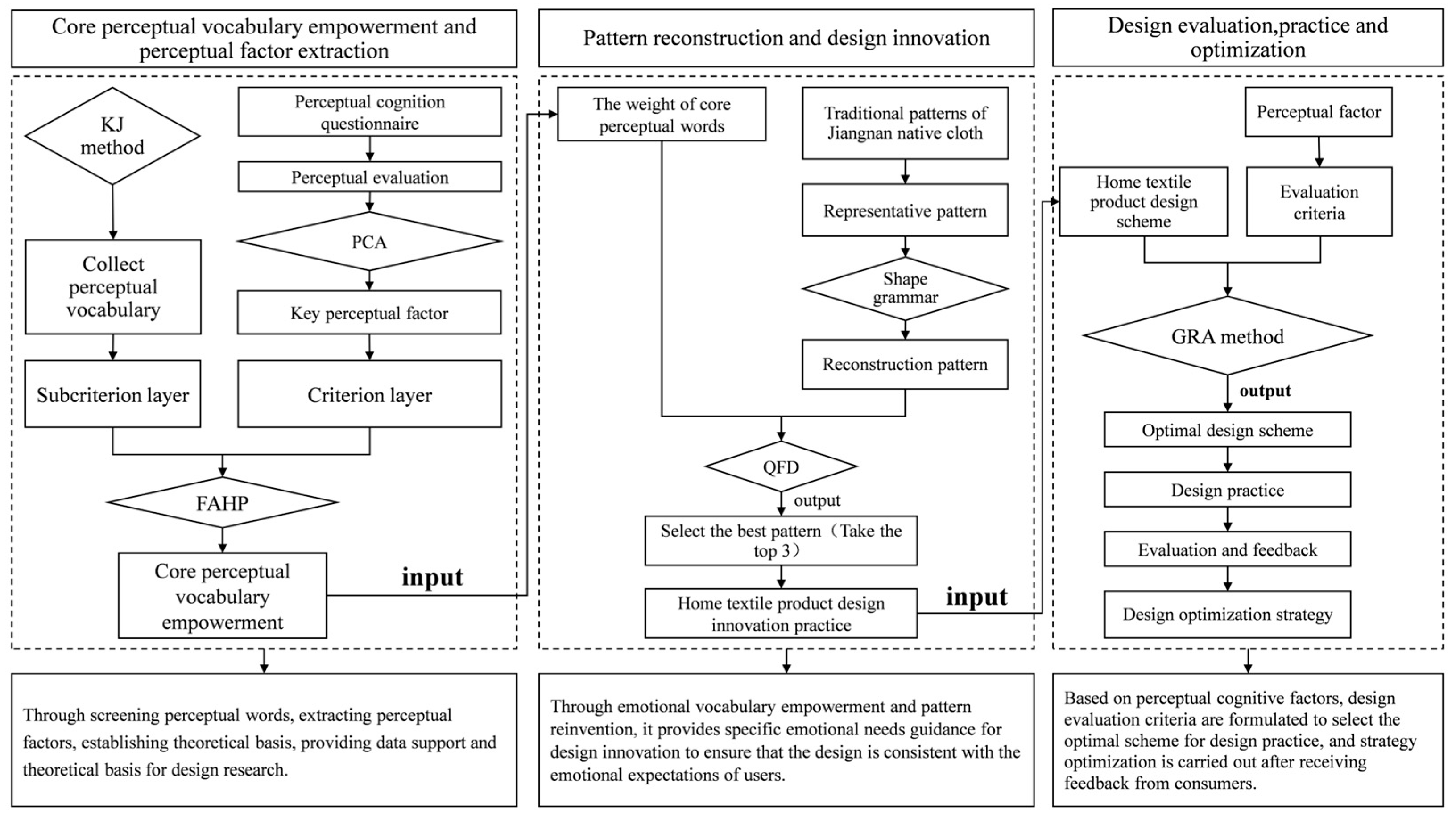
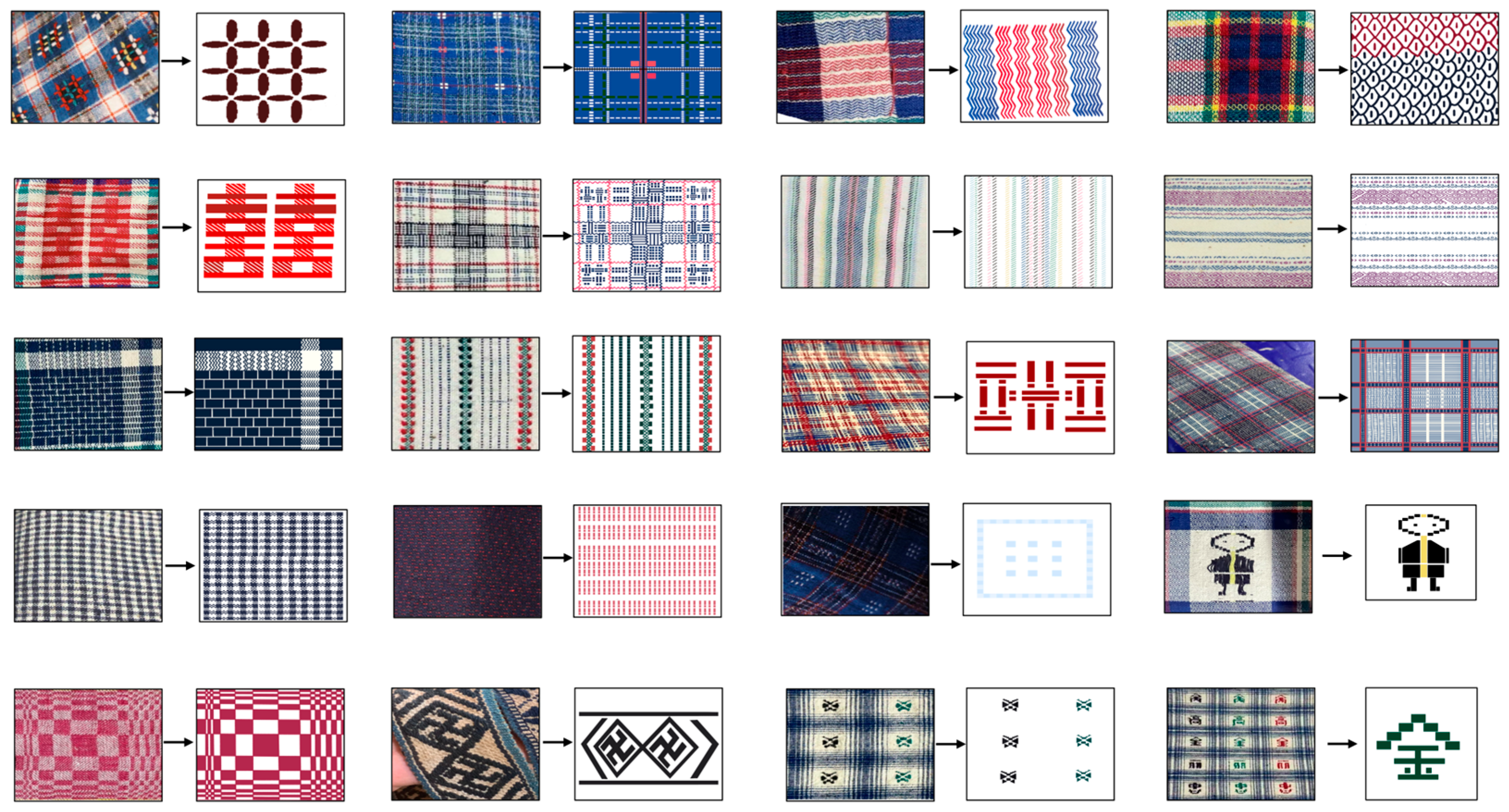
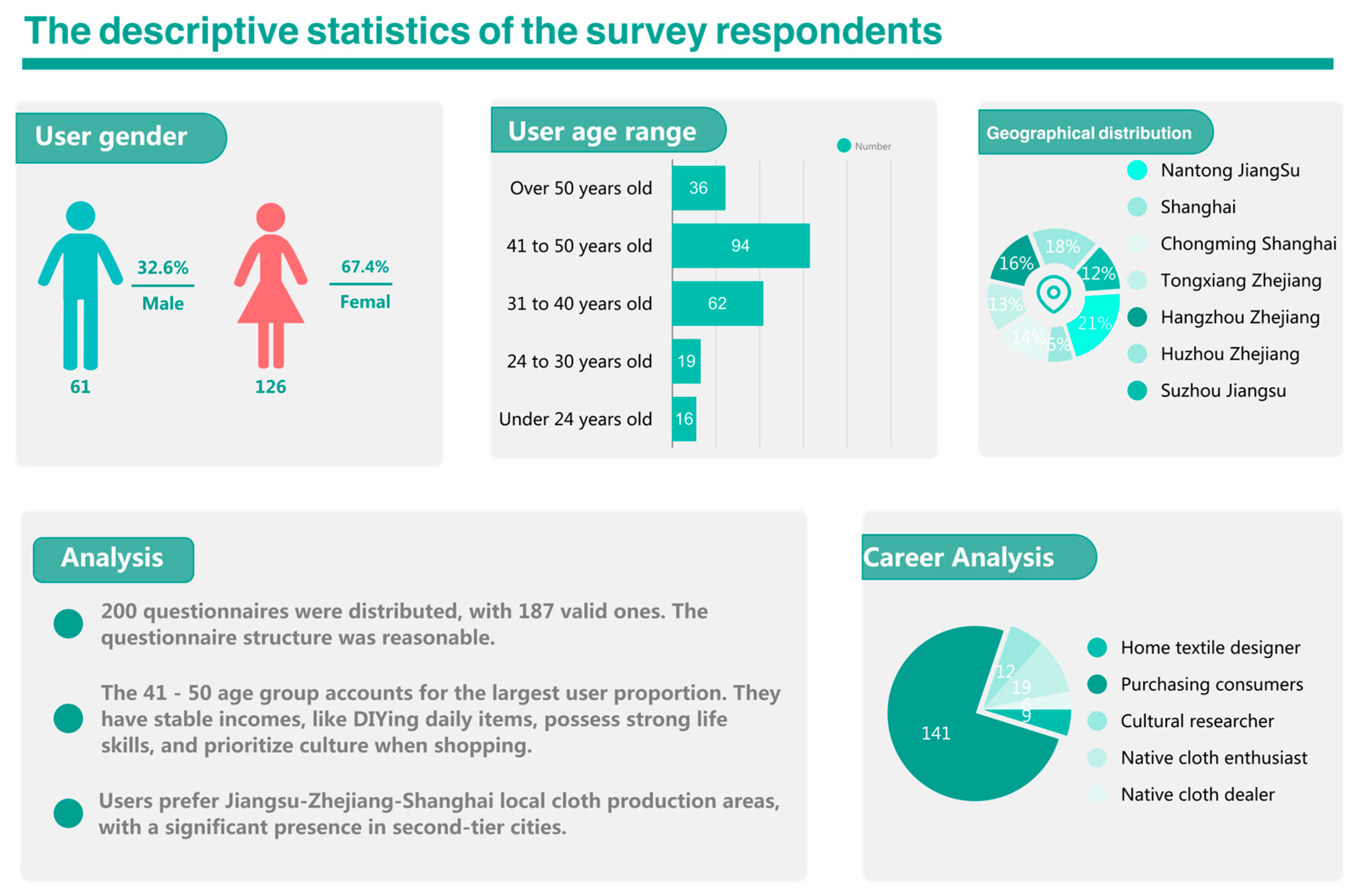
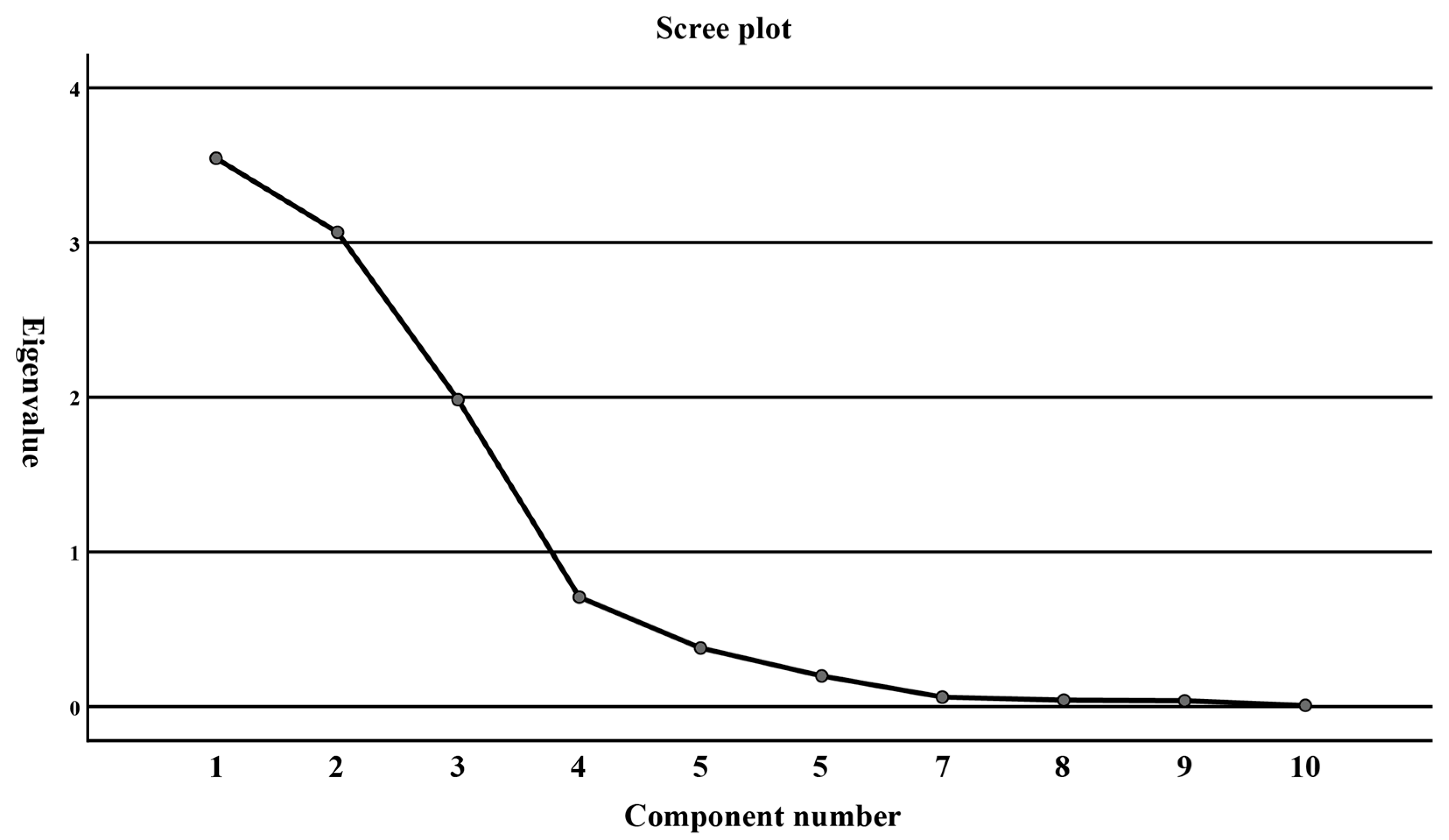
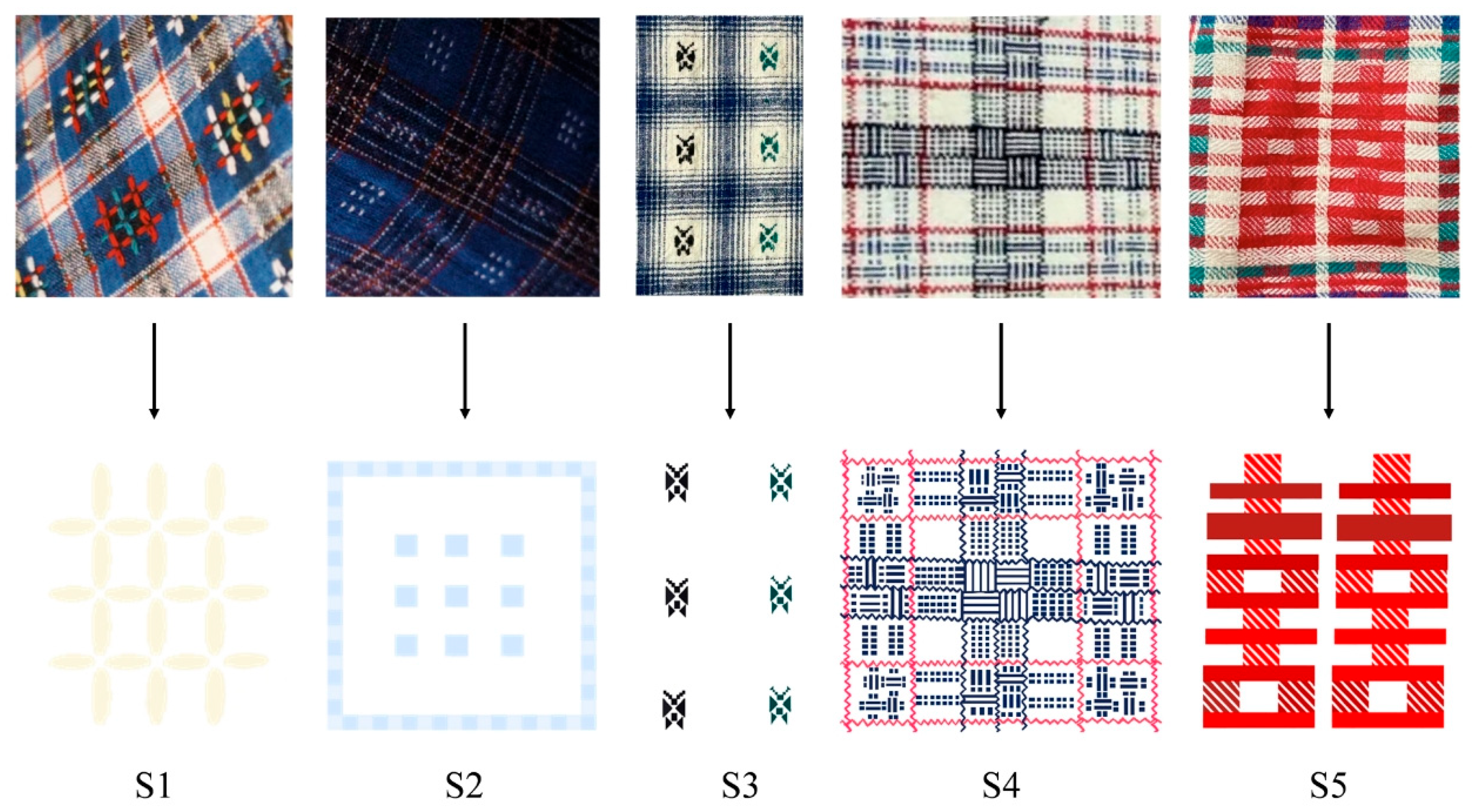



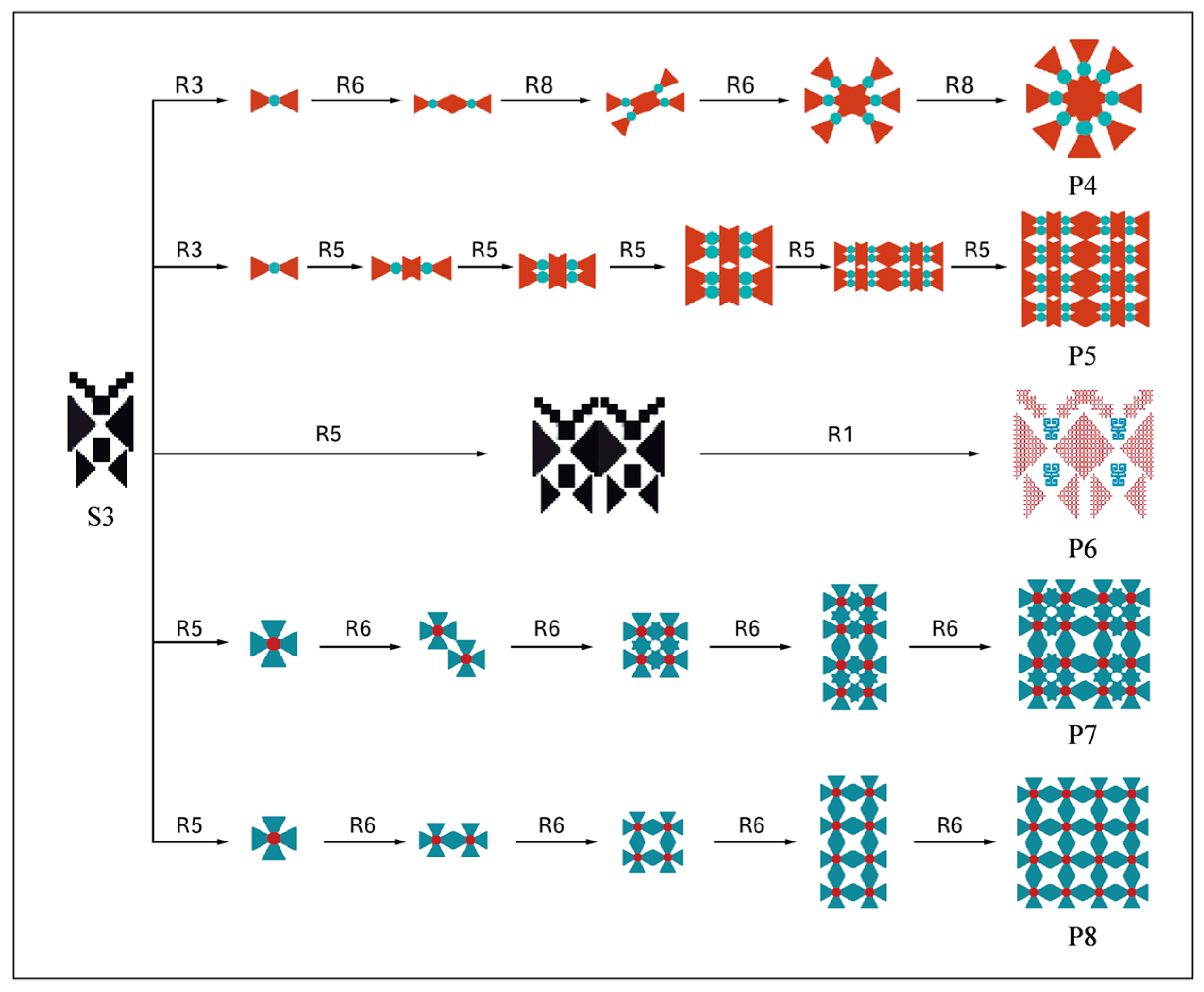
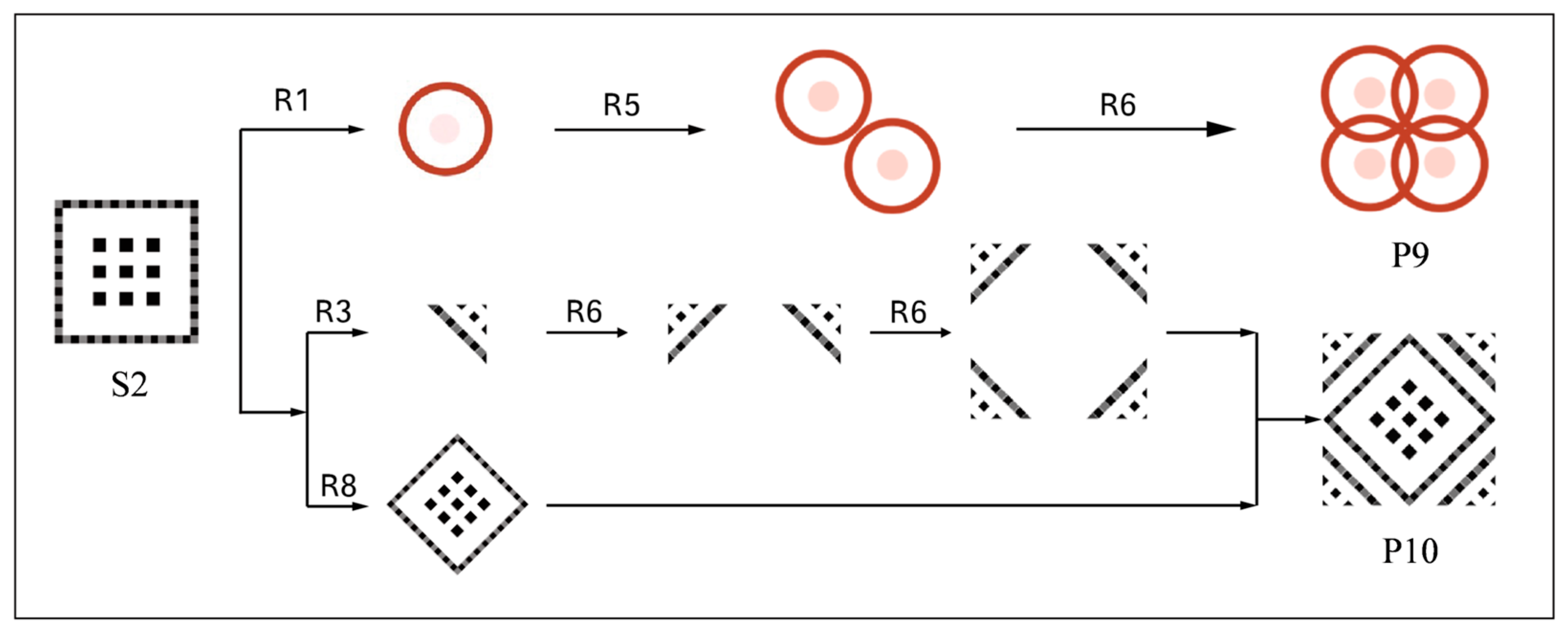
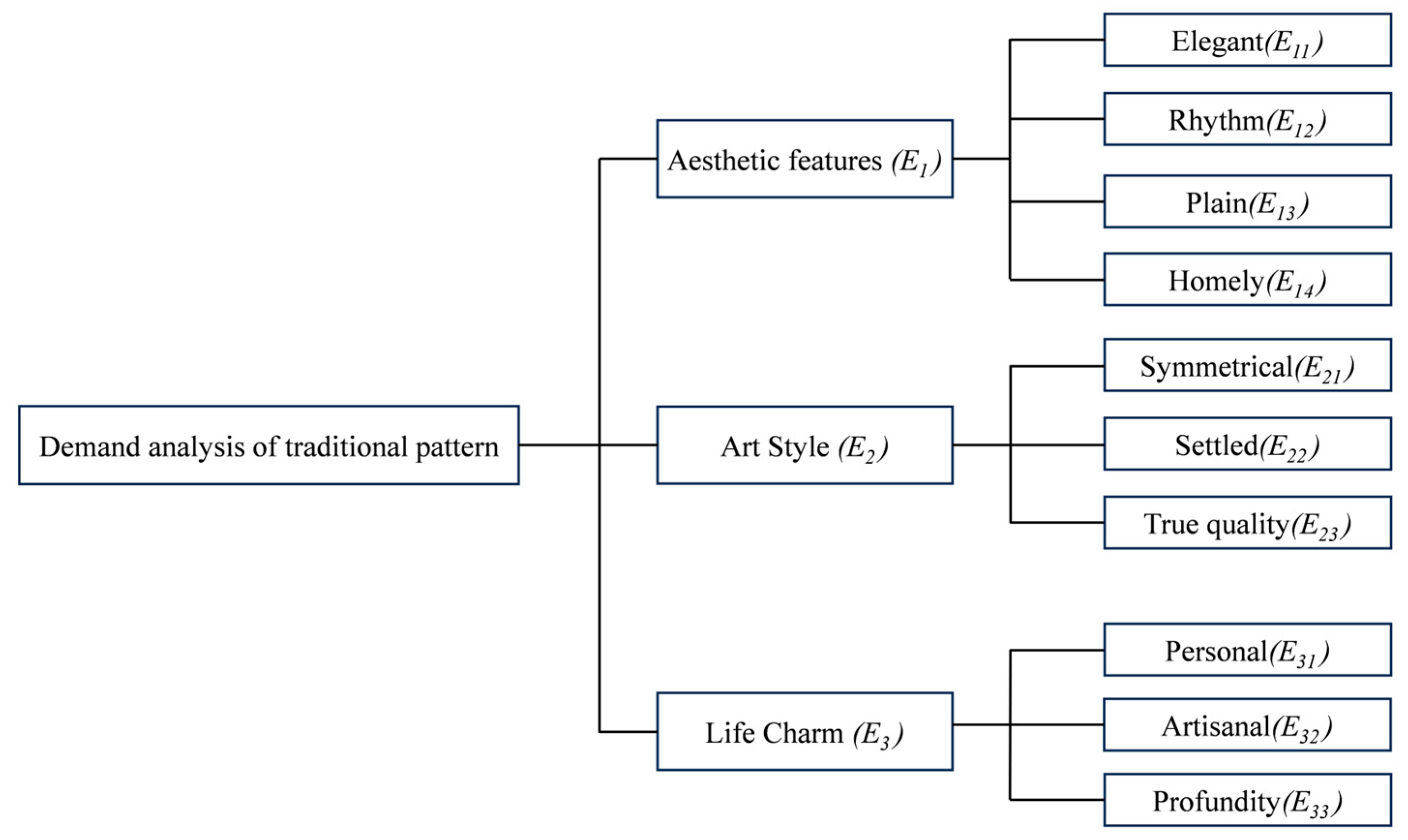
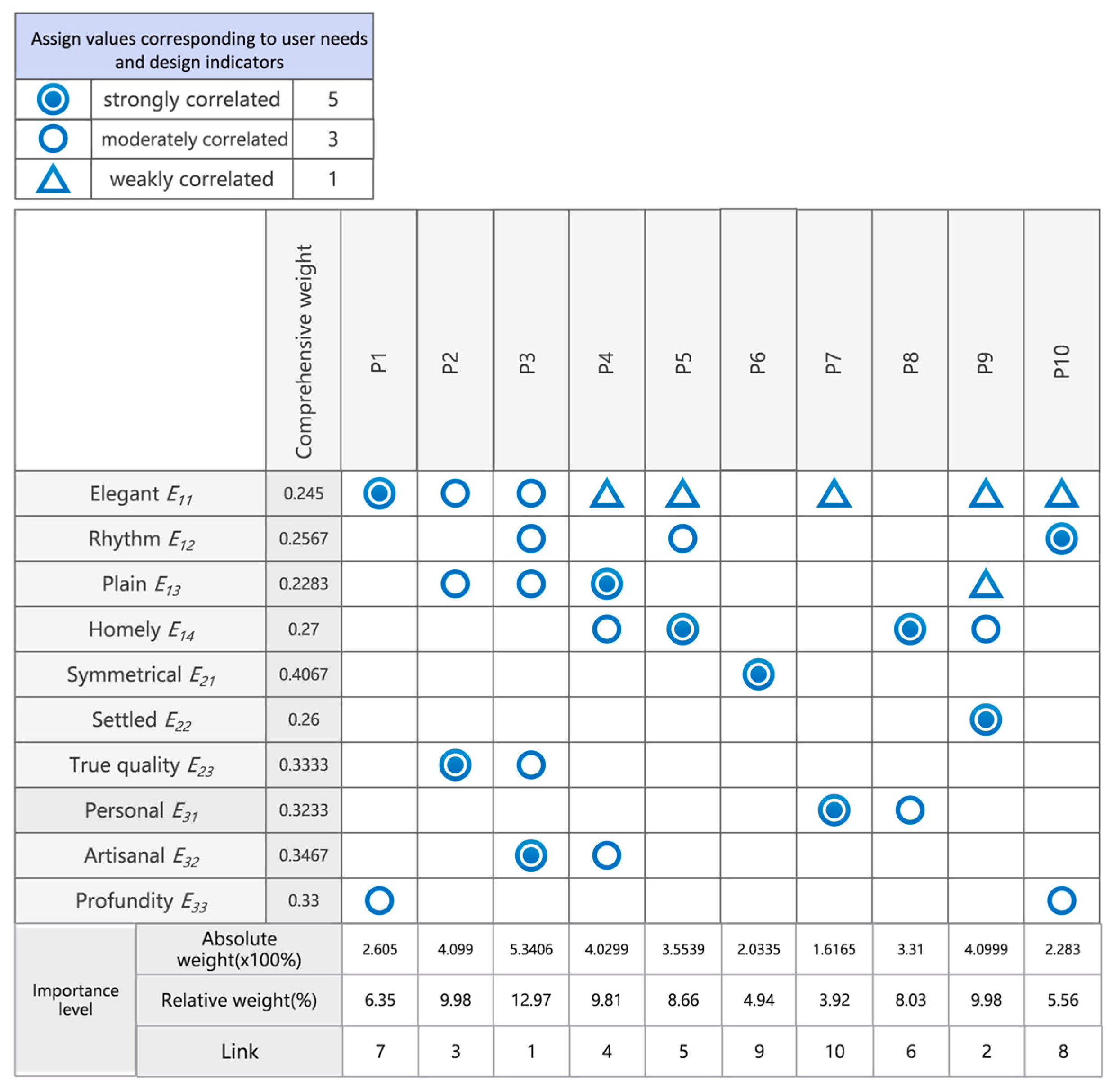
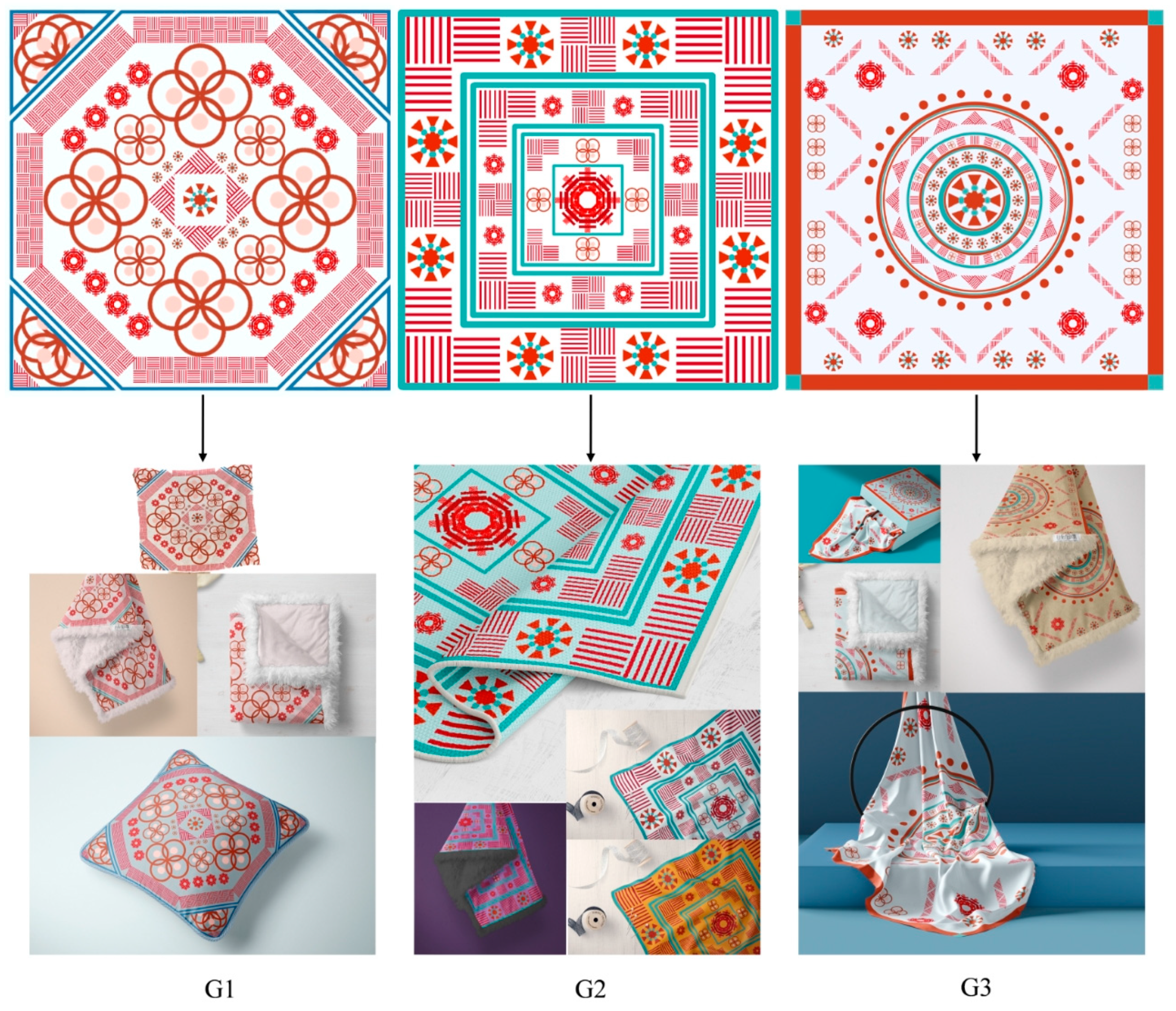
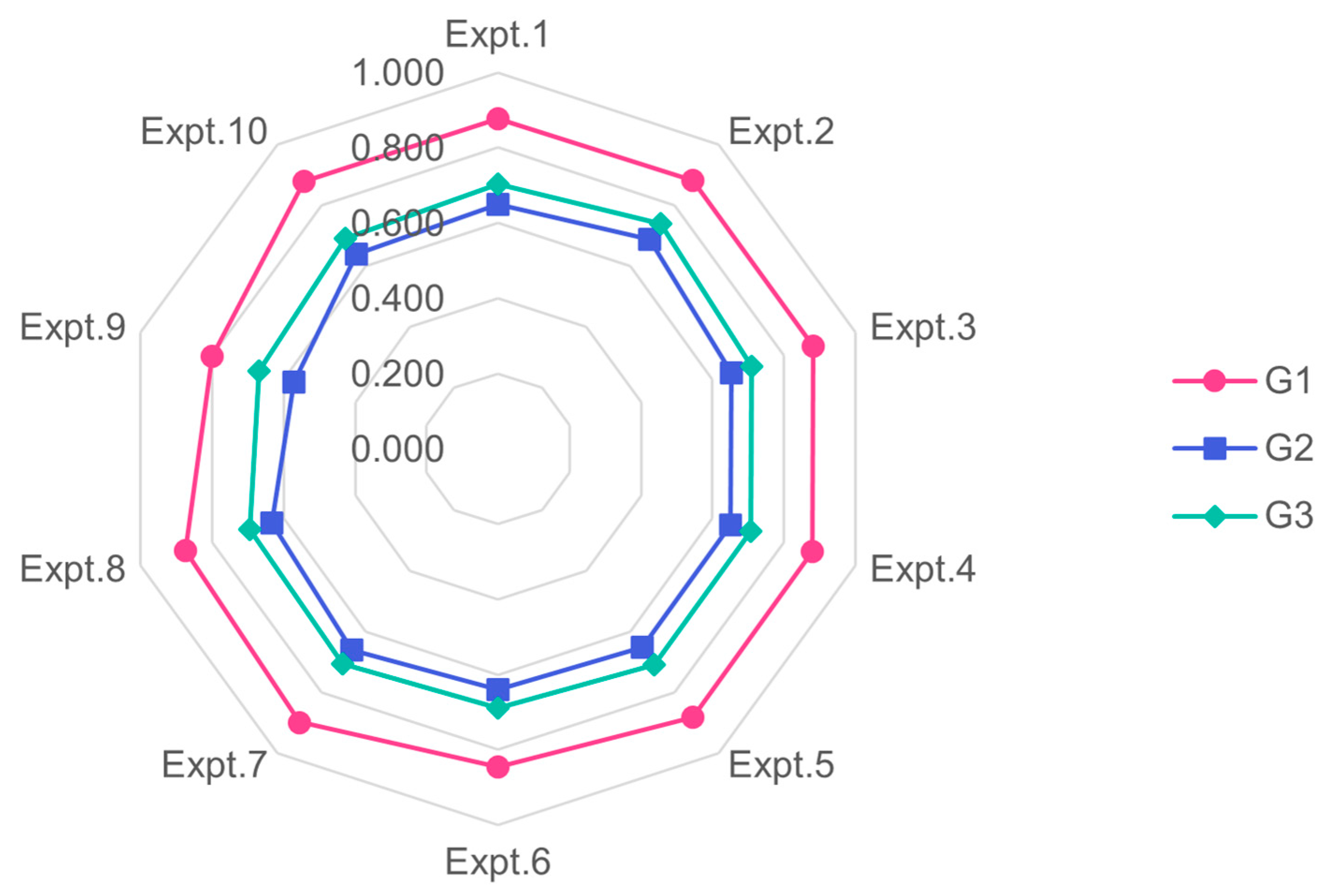
| Type | Rule | Formula | Diagram |
|---|---|---|---|
| Build rules | R1 = Substitution |  | |
| R2 = Addition |  | ||
| R3 = Deletion |  | ||
| Amend rules | R4 = Scaling |  | |
| R5 = Duplication |  | ||
| R6 = Mirroring |  | ||
| R7 = Shearing |  | ||
| R8 = Rotation |  | ||
| R9 = Fine-Tuning |  | ||
| Derived rules | R10 = Merging |  | |
| R11 = Translation |  |
| Score | Definition | Score | Definition |
|---|---|---|---|
| 0.1 | Factor is absolutely less important than factor | 0.6 | Factor is slightly more important than factor |
| 0.2 | Factor is extremely less important than factor | 0.7 | Factor is relatively more important than factor |
| 0.3 | Factor is relatively less important than factor | 0.8 | Factor is extremely more important than factor |
| 0.4 | Factor is slightly less important than factor | 0.9 | Factor is absolutely more important than factor |
| 0.5 | Factor is equally important as factor |
| KMO | 0.605 | |
|---|---|---|
| Bartlett Sphericity Check | Approximate Chi-square | 211.238 |
| df | 45 | |
| p | 0.000 | |
| Initial Eigenvalue | Sum of Squared Loadings Extracted | Sum of Squared Loadings After Rotation | |||||||
|---|---|---|---|---|---|---|---|---|---|
| Element | Total | Percentage of Variance | Cumulative % | Total | Percentage of Variance | Cumulative % | Total | Percentage of Variance | Cumulative % |
| 1 | 3.541 | 35.409 | 35.409 | 3.541 | 35.409 | 35.409 | 3.320 | 33.201 | 33.201 |
| 2 | 3.065 | 30.654 | 66.062 | 3.065 | 30.654 | 66.062 | 2.807 | 28.069 | 61.270 |
| 3 | 1.976 | 19.760 | 85.822 | 1.976 | 19.760 | 85.822 | 2.455 | 24.553 | 85.822 |
| 4 | 0.708 | 7.079 | 92.901 | ||||||
| 5 | 0.375 | 3.750 | 96.651 | ||||||
| 6 | 0.197 | 1.974 | 98.625 | ||||||
| 7 | 0.058 | 0.577 | 99.201 | ||||||
| 8 | 0.039 | 0.391 | 99.592 | ||||||
| 9 | 0.033 | 0.329 | 99.922 | ||||||
| 10 | 0.008 | 0.078 | 100.000 | ||||||
| Component | |||
|---|---|---|---|
| Component 1 | Component 2 | Component 3 | |
| Elegant | 0.909 | −0.150 | −0.158 |
| Rhythm | 0.898 | −0.289 | −0.255 |
| Plain | 0.833 | 0.393 | 0.127 |
| Homely | 0.811 | 0.392 | 0.031 |
| Symmetrical | −0.065 | 0.921 | −0.173 |
| Settled | 0.076 | 0.915 | 0.307 |
| True quality | 0.113 | 0.829 | 0.082 |
| Personal | −0.175 | 0.073 | 0.962 |
| Artisanal | −0.189 | 0.009 | 0.914 |
| Profundity | 0.497 | 0.116 | 0.675 |
| Criterion Level | Sub-Criterion Level |
|---|---|
| Aesthetic Features (E1) | Elegant (E11), Rhythm (E12), Plain (E13), Homely (E14) |
| Art Style (E2) | Symmetrical (E21), Settled (E22), True quality (E23) |
| Life Charm (E3) | Personal (E31), Artisanal (E32), Profundity (E33) |
| Objective Layer | Criterion Layer | |||
|---|---|---|---|---|
| E1 | E2 | E3 | ||
| CI | 0.0067 | 0.005 | 0.022 | 0.0378 |
| Criterion Level | Sub-Criterion Level | Same-Level Weights | Global Weights | Ranking |
|---|---|---|---|---|
| E1 (0.41) | E11 | 0.2450 | 0.1005 | 5 |
| E12 | 0.2567 | 0.1052 | 4 | |
| E13 | 0.2283 | 0.0936 | 6 | |
| E14 | 0.2700 | 0.1107 | 2 | |
| E2 (0.32) | E21 | 0.4067 | 0.1301 | 1 |
| E22 | 0.2600 | 0.0832 | 10 | |
| E23 | 0.3333 | 0.1067 | 3 | |
| E3 (0.27) | E31 | 0.3233 | 0.0873 | 9 |
| E32 | 0.3467 | 0.0936 | 7 | |
| E33 | 0.3300 | 0.0891 | 8 |
| Evaluation Dimensions | Reference Sequence | G1 | G2 | G3 |
|---|---|---|---|---|
| Pattern Innovation (N1) | 0.72 | 0.72 | 0.57 | 0.56 |
| Home Textile Applicability (N2) | 0.71 | 0.71 | 0.58 | 0.58 |
| Market Acceptance (N3) | 0.77 | 0.77 | 0.67 | 0.61 |
| Degree of Cultural Inheritance (N4) | 0.81 | 0.64 | 0.81 | 0.59 |
| Potential for Personalization (N5) | 0.76 | 0.76 | 0.57 | 0.59 |
| Evaluation Dimensions | G1 | G2 | G3 |
|---|---|---|---|
| Pattern Innovation (N1) | 1.000 | 0.423 | 0.407 |
| Home Textile Applicability (N2) | 1.000 | 0.458 | 0.458 |
| Market Acceptance (N3) | 1.000 | 0.524 | 0.407 |
| Degree of Cultural Inheritance (N4) | 0.393 | 1.000 | 0.333 |
| Potential for Personalization (N5) | 1.000 | 0.367 | 0.393 |
| Degree of correlation | 0.879 | 0.554 | 0.4 |
| Ranking | 1 | 2 | 3 |
| Study | Methodologies Employed | Key Contributions |
|---|---|---|
| This study | Affinity Diagram; FAHP; SG; QFD; GRA | - User-centered emotional demand analysis - Integration of qualitative and quantitative methods - Construction of a comprehensive evaluation model - Emphasis on cultural inheritance and innovation in home textile design |
| Zou, Y [3] | Field Investigation; Participatory Research; AHP | - Identified gaps in cross-cultural fashion design - Addressed cultural understanding and strategy formation - Lacked a systematic evaluation framework |
| Miao, H [4] | Case Analysis; Market Research | - Explored innovative uses of traditional patterns - Emphasized integration of clothing elements - Focused on practical design coordination rather than emotional evaluation |
| Shen, Y [5] | AHP; GRA; TOPSIS | - Tackled issues of product homogeneity and low innovation in campus cultural products - Developed a GC-TOPSIS-based evaluation model - Focused mainly on selection, not on creation |
Disclaimer/Publisher’s Note: The statements, opinions and data contained in all publications are solely those of the individual author(s) and contributor(s) and not of MDPI and/or the editor(s). MDPI and/or the editor(s) disclaim responsibility for any injury to people or property resulting from any ideas, methods, instructions or products referred to in the content. |
© 2025 by the authors. Licensee MDPI, Basel, Switzerland. This article is an open access article distributed under the terms and conditions of the Creative Commons Attribution (CC BY) license (https://creativecommons.org/licenses/by/4.0/).
Share and Cite
Qin, M.; Wang, J.; Ding, X.; Zhang, H. Symmetrical Traditional Patterns and User Perception: A Study on Innovation in Home Textile Design. Symmetry 2025, 17, 960. https://doi.org/10.3390/sym17060960
Qin M, Wang J, Ding X, Zhang H. Symmetrical Traditional Patterns and User Perception: A Study on Innovation in Home Textile Design. Symmetry. 2025; 17(6):960. https://doi.org/10.3390/sym17060960
Chicago/Turabian StyleQin, Mengqi, Jianfang Wang, Xueying Ding, and Haihong Zhang. 2025. "Symmetrical Traditional Patterns and User Perception: A Study on Innovation in Home Textile Design" Symmetry 17, no. 6: 960. https://doi.org/10.3390/sym17060960
APA StyleQin, M., Wang, J., Ding, X., & Zhang, H. (2025). Symmetrical Traditional Patterns and User Perception: A Study on Innovation in Home Textile Design. Symmetry, 17(6), 960. https://doi.org/10.3390/sym17060960






